#ancient near east
Text
SO yesterday I had a guest professor who
spent well over 10 minutes showing us memes about Ea-Nasir
Wondered if the Babylonians wore skirts because of 'the flow down under'
Called like all the kings in the Ancient Near East cute
Called all of us darlings, multiple times
Casually brought VERY valuable clay tablets to our lesson in a tin cookie jar
Proudly exclaimed 'I'm the father' while explaining pregnant tablets (clay tablets with another clay tablet in them)
'What happens in the office between me and the tablets, stays in the office between me and the tablets'
Casually said he was the first ever to put a tablet in a particle accelerator LIKE LAST WEEK
Had an absolutely FIRE powerpoint
Showed us a picture of a cute dog just because
What a legend
108 notes
·
View notes
Text

Line drawing of an impression from the cylinder seal of Shar-Kali-Sharri, ruler of the Akkadian Empire ca. 2217-2193 BCE. On the right of the impression, the hero Gilgamesh wrestles with a lion. From The Seal Cylinders of Western Asia by William Hayes Ward, published in 1910.
#art#art history#ancient art#Ancient Near East#Mesopotamia#history#ancient history#Akkadian#Akkadian Empire#Shar-Kali-Sharri#cylinder seal#cuneiform#Gilgamesh
47 notes
·
View notes
Text
Gold Tablet from the Temple of Ištar in Aššur, Assyria (modern-day Iraq) c.1243-1207 BCE: this tablet was discovered within the foundations of the ancient temple; it measures just over 3cm (1in) in length
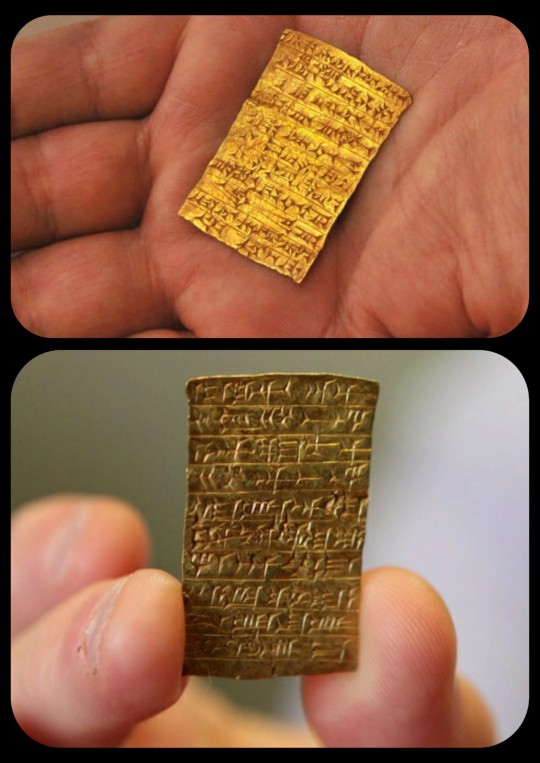
The cuneiform inscription honors King Tukulti-Ninurta I, who had ordered the construction of the temple, and describes how the building was constructed. This is just one of the many items that had been buried around the temple with similar inscriptions.
As this article explains:
Most of [the inscriptions installed in the temple] would not have been visible while the temple was still in use, as they were laid into the sanctuary’s foundations or walls. Tukulti-Ninurta commissioned a great number of objects carrying variations of the inscription commemorating his achievement of erecting the new temple.
The practice of depositing inscriptions directed at the gods as well as future generations had become a central element of the temple building process since the Early Dynastic Period, and was employed to immortalize the ruler by eternally associating his name with a monumental building such as the Ištar temple - a process that also transformed a sanctuary into a votive object dedicated to a deity.
It took several hours of searching (i.e. scouring through old artifact catalogs) for me to find a direct translation of the inscription on this particular tablet, and I could basically only find it in a PDF of an old bibliographic manuscript that isn't even in print anymore, but here it is:
Tukulti-Ninurta, king of the universe, king of Assyria, son of Shalmaneser, king of Assyria: at that time the temple of the goddess Ištar, my mistress, which Ilu-šumma, my forefather, the prince, had previously built — that temple had become dilapidated. I cleared away its debris down to the bottom of the foundation pit. I rebuilt from top to bottom and deposited my monumental inscription. May a later prince restore it and return my inscribed name to its place. Then Aššur will listen to his prayers.
This tablet was stolen from the Vorderasiatisches Museum in Berlin back in 1945, during the chaotic final days of WWII. It was then lost for almost 60 years before it finally re-emerged in 2006, when a Holocaust survivor named Riven Flamenbaum passed away and the tablet was found among his belongings. According to his family, Flamenbaum had gotten the tablet from a Soviet soldier (in exchange for two packs of cigarettes) at the end of the war.
In 2013, following a lengthy legal battle between Riven Flamenbaum's family and the Vorderasiatisches Museum in Germany, a court in New York ordered the family to return the tablet back to the museum.
Sources & More Info:
Albert Kirk Grayson: Assyrian Rulers of the Third and Second Millennia BC (to 1115 BC) (the translation appears on p.261)
Daniel Luckenbill: Ancient Records of Assyria and Babylonia, Volume 1 (PDF download; p.65 contains relevant info)
CTV News: 3,000-year-old Assyrian Gold Tablet Returned to German Museum
#archaeology#history#anthropology#ancient history#assyria#mesopotamia#golden tablet#cuneiform#artifact#ancient iraq#iraq#ancient near east#middle east#ishtar#pagan deities#polytheism#return the slab
346 notes
·
View notes
Text

120 notes
·
View notes
Text

Under the adobe of Olympian palace 🏛️🏺🪔
Heavily inspired by Professor Jenks-Brown @greekmythcomix’s #Classicstober - even though deals with love magic, charms, amulets, & potions of the ancient Eastern Mediterranean-Near Eastern world (an idea from my friend, @aimee-maroux, who happened to be writing erotic stories of the Greek gods, also.)
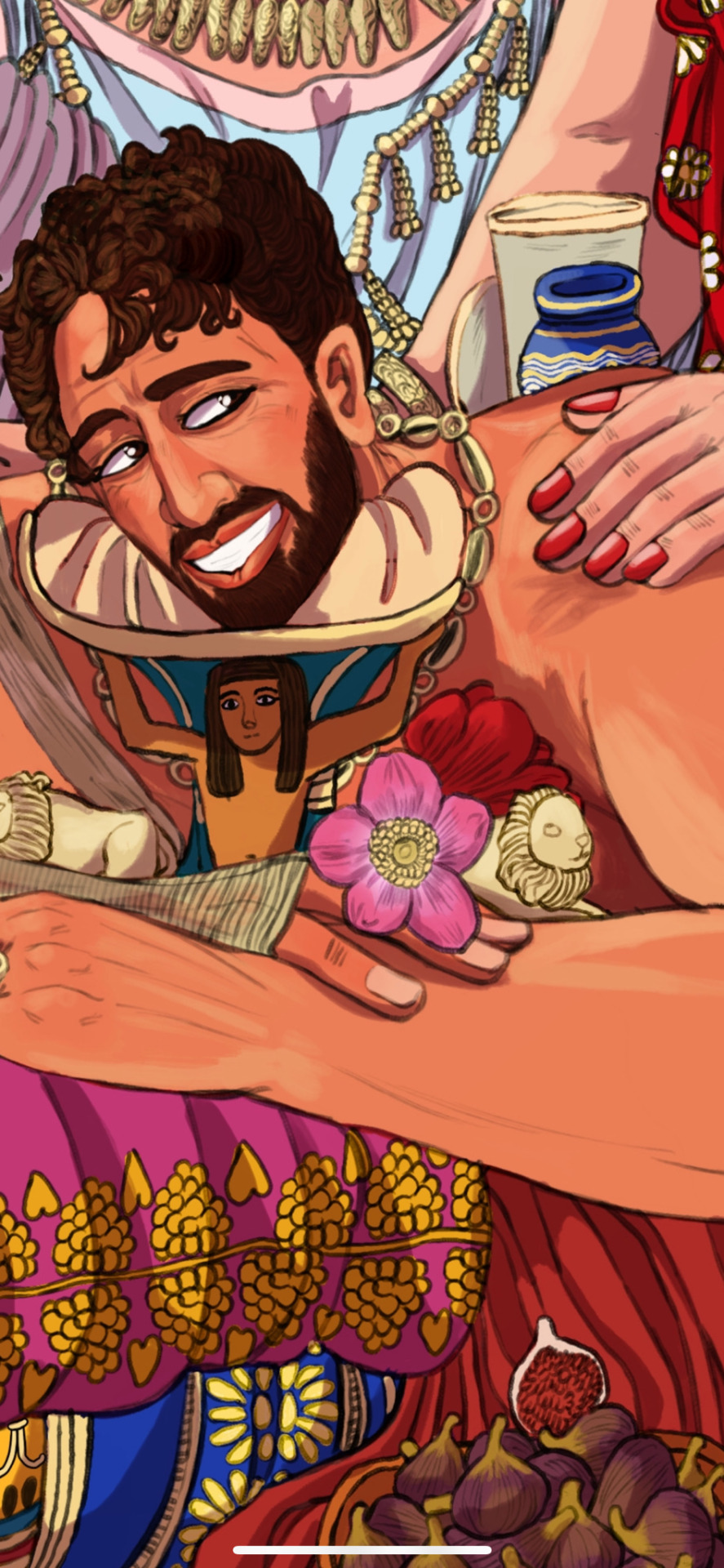
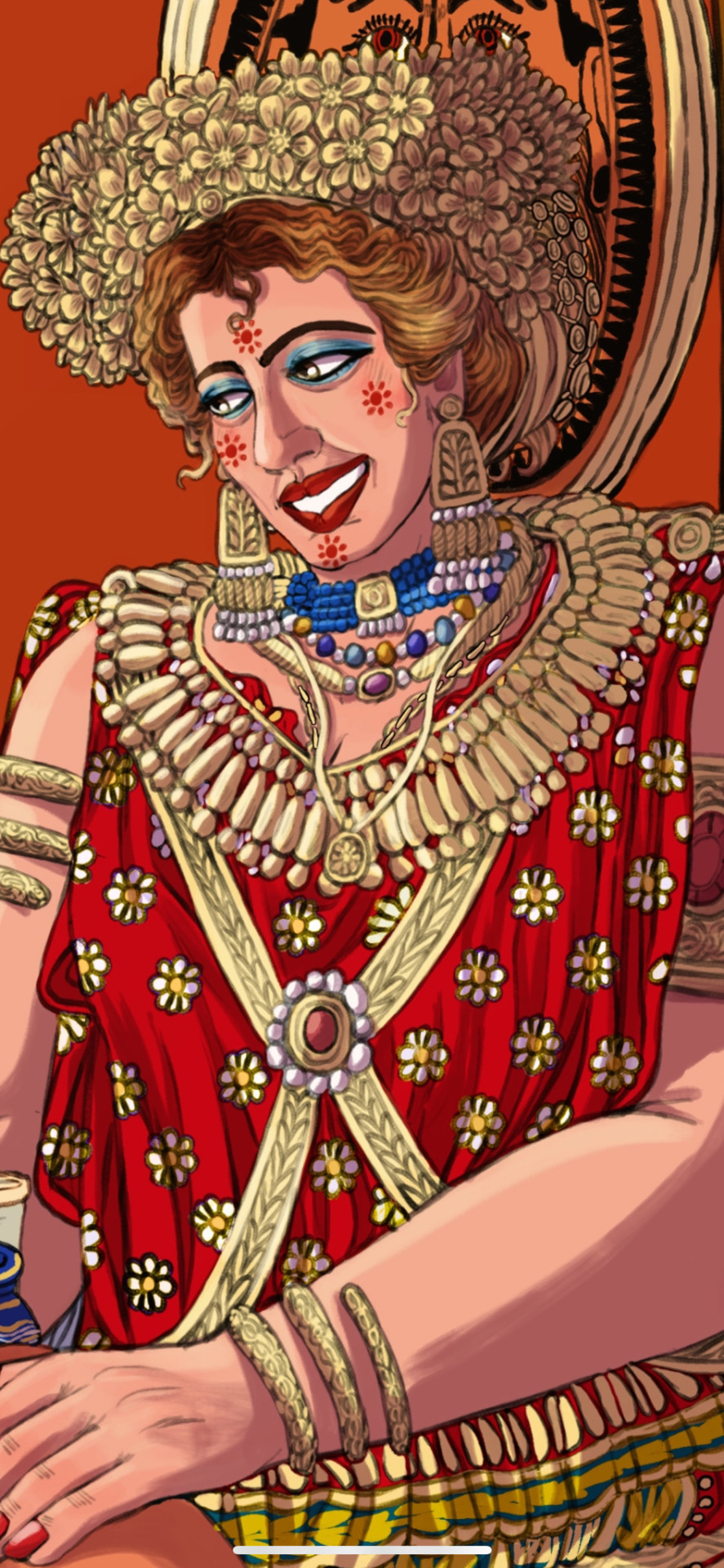
Ares feels worn down from carrying the heavy war armor and weapons all the time, while his wounds haven’t been healed enough yet. This often leads to Aphrodite’s messaging one of Ares’ wounds with her magic love potions/charms and both of them cuddling, smooching, and having their passionate nights later afterward. The magical love potions/charms of late antiquity are all Ancient Greek, Ancient Near Eastern (especially Babylonians, Assyrians and Phoenicians) & Ancient Egyptian; as her home, Cyprus is a melting pot of all of them.


From right to left on the 1st table: the Ancient Greek honey cheesecake, figs, pomegranates, dates, grapes, mandrakes, and Roman honey cookies (often filled with various types of nuts, opium seeds & almonds) While the mandrake tree - often associated with witchcraft & magic - wasn’t popular among the Ancient Greek society per se (as they often burning them as incense), it is widely used as a tree of love & fertility/ a fortune amulet in Ancient Egypt & Near East. As cousins of the nightshade, mandrake is both hallucinogenic & narcotic, and small usages of the tree have been used as a surgical anesthetic/ pain relief in ancient times. The 2nd table got the main vegetarian meal, of course: hearty red lentil saffron soup & Greek pita bread. I plan to add a silver tray of oysters to it, but I don't think it will fit in the aphrodisiac collection. The final table was filled with apples, wine & several love potions/ amulets that the goddess currently working on.
#ancient greek#aphrodite#ares#my art#mars#venus#ancient egypt#ancient near east#classicstober#classicstober2023#witchcraft#love magic#love charms#love amulet#love potion#Halloween
47 notes
·
View notes
Text
Ereškigal Festival


[Alt text is generated by iOS with minor proof read sorry if there are inaccuracies]
*screams* I finally found an actual source. "Ereškigal doesn't have cult worship" is bullshit, begone.
— From The Cultic Calendars of the Ancient Near East by Cohen pages 351 & 355
#polytheism#paganism#landof2rivers#Ereškigal#ereshkigal#myqueen#syrian#emar#ancient near east#mesopotamian#amorite#a physical copy of this book is $100+ 😒
16 notes
·
View notes
Text

Mosaic with Personification of the River Tigris, late 100-200
Roman culture, excavated at Antioch, Southern Turkey
75 notes
·
View notes
Text
Unfortunately, true
Although in the case of Carthage, some of the problem is a lack of evidence. The other problem is the issue of languages: what's taught. A lot easier to find classes on Latin than Akkadian, if you want to study Neo-Assyria, say. ;-)

#ancient mediterranean studies#Classics#Classics humor#Classics memes#ANE#ancient near east#carthage#Phoenicia#ancient Persia#ancient Mesopotamia
80 notes
·
View notes
Text
„Another likely allusion to a Near Eastern story in the Iliad is Poseidon’s account of how he, Zeus and Hades divided the world by lot (Il. 15.185-195). … After Hera has seduced Zeus and put him to sleep, Poseidon helps the Greeks to regain the upper hand in the war. When Zeus wakes up, he is angry and sends the goddess Iris to tell Poseidon that he should withdraw from the battle and obey him. After Iris has reported Zeus’ words, Poseidon replies to her as follows: Well now, surely, though he is noble, he has spoken arrogantly, if by force and against my will he will restrain me who have equal honor with himself. For three brothers are we, begotten by Cronos, and born of Rhea—Zeus, and myself, and the third is Hades, who is lord of the dead below. And in three ways have all things been divided among us, and to each has been apportioned his own domain. I indeed, when the lots were shaken, won the grey sea to be my home for ever, and Hades won the murky darkness, while Zeus won the broad heaven in the air and the clouds; but the earth and high Olympus still remain common to us all. So I will in no way walk according to the will of Zeus; but at his ease let him remain in his third portion, no matter how strong he may be. Il. 15.185-195
Burkert was the first, to my knowledge, who recognized in the division of the world into three parts by Zeus and his brothers through the casting of lots a possible allusion to the Near Eastern story of Atrahasis, the man who survived the great flood. Close to the beginning of this story we are told that three generations of gods divided heaven, earth and sea also by the casting of lots: They had taken the [clay jar?] by the neck, They cast lots, the gods took their shares: Anu went up to heaven, [Enlil took the earth for his subjects, [The bolt], the trap of the sea, [They had given to Enki the leader. An even closer parallel may have existed in Ugarit, where the three sons of El, the father of the gods, divide the world among themselves: Baal, who is the equivalent of Zeus in several ways, rules the sky, Yam the sea, and Mot the underworld. The text is very fragmentary, however, and it is unclear if they did so by the casting of lots. If they did, it may well be that this is the version of the story on which Poseidon’s account is based.
This account differs fundamentally from the other Greek traditions we encounter in Homer or Hesiod relating to the manner in which power was distributed among the gods. In the Iliad Zeus claims to rule the gods because he is the eldest and the strongest of the Olympians. He says so to Iris just before Poseidon’s speech: And if he will not obey my words, but will disregard them, let him consider then in mind and heart lest, strong though he be, he has not the courage to face my reproach; since I say I am better far than he in might, and the elder by birth. Yet his heart does not hesitate at all to declare himself the equal of me, whom the other gods dread. Il. 15.162-167
Iris repeats the same words to Poseidon in lines 178-183 and after Poseidon’s speech she reminds him again that Zeus is the eldest and, because of this, his authority is upheld by the Erinyes (Il. 15.201-204). These statements do not match Poseidon’s claim that Zeus’ authority is restricted to the heavens and that he and Zeus have an equal say on earth and on Olympus. In the Theogony we are told that the Olympian gods, after they had defeated the Titans, asked Zeus to rule over them and that it was Zeus who divided their honours among them: When the blessed gods had completed their toil, and by force had reached a settlement with the Titans regarding honors, then by the prophecies of earth they urged far-seeing, Olympian Zeus to become king and to rule over the immortals; and he divided their honors well for them. Hes. Th. 881-885 No mention is made of the casting of lots, certainly not where Zeus’ domain or authority is concerned. Note that Zeus in this passage is already referred to as the ‘Olympian’ before any division is made. If the assumption is that the honours of the gods were divided by the throwing of lots, it appears that Zeus is presiding over this division, not participating in it, as also seems to be the case in Pindar’s Olympian 7.
For Poseidon’s claim that the three brothers divided the world by lot there is support in local Greek practice. It was common among the Greeks for brothers to divide parts of the inheritance by lot. Such a division assumes, however, that the brothers are more or less equal, but this is not the case with Zeus and his brothers. The portions in this case are far from equal too. In most other theogonic accounts from Greece, Zeus plays the leading role in establishing the rule of the Olympian gods. After the Olympian gods defeat the Titans, the other gods recognize him as their king, as Hesiod’s Theogony says. Is it really conceivable that Zeus subsequently would have cast lots, running the risk of winding up in the underworld or the sea, and relinquished his right to rule over the earth and Olympus? It is very difficult to reconcile Poseidon’s story with other extant accounts of how Zeus came to power. Later Greeks therefore could question it, as Callimachus does in his Hymn to Zeus.
Poseidon through this story claims that he and Zeus are equal partners and have an equal right to rule over the earth and Olympus. Is there any reason to think that Poseidon would make up such a claim?There is. Zeus at the end of his speech to Iris says about Poseidon: ‘his heart does not hesitate at all to declare himself the equal of me’ (Il. 15.166-167). Iris repeats these words to Poseidon in lines 182-183. What we subsequently get is a display of Poseidon’s tendency to declare himself the equal of Zeus. He does so explicitly in line 186: ‘[Zeus wrongs] me who has equal honour with him’. In support of this claim he recites an oriental cosmogony, in which gods share the world equally among themselves by lot, and presents it as something that really happened. Iris does not buy it, however. She asks Poseidon if he really wants her to relate these words to Zeus, because in her eyes they do not do justice to Zeus’ authority (Il. 15.201-204). Poseidon then relents: he says that he will obey and Iris should not tell the story to Zeus. All of this makes good sense if Poseidon is referring to a story that Homer’s audience would have recognized as a lie.”
-Eastern Myths for Western Lies: Allusions to Near Eastern Mythology in Homer's Iliad by André Lardinois
#the iliad#greek mythology#ancient near east#near eastern mythology#greek gods#poseidon#zeus#hades#quotes#excerpts
8 notes
·
View notes
Text

𒀭𒈹 𒅇 𒀭𒌓
Inanna and Utu
They are my favorite Mesopotamian god and goddess.
12 notes
·
View notes
Text
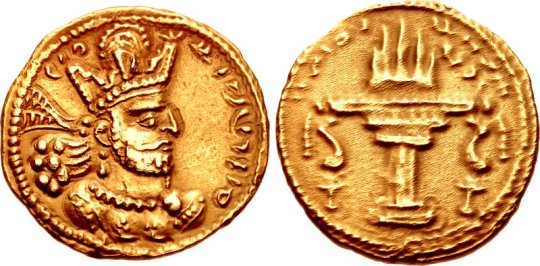
Gold coin of Shapur (Šābuhr) II "the Great," king of Sassanid Persia from 309 to 379 CE. On the obverse, the bust of Shapur, wearing a mural crown topped with the jewel-studded globe known as a korymbos; on the reverse, a fire altar, reflecting Shapur's aggressive promotion of Zoroastrianism within his realm. Artist unknown; minted ca. 320 CE and found in the present-day nation of Georgia. Photo credit: Classical Numismatic Group, Inc. http://www.cngcoins.com
#history#ancient history#Near East#Ancient Near East#Persia#Ancient Persia#Persian Empire#Sassanids#Sassanid Persia#Shapur II#art#art history#ancient art#Near Eastern art#Ancient Near Eastern art#Persian art#coins#ancient coins#numismatics#ancient numismatics#gold#goldwork#Zoroastrianism
152 notes
·
View notes
Text
I set up a Tumblr profile in 2017, with a then wife. We found it interesting but a bit confusing. Then she died in 2018. I’ve logged in a few times over the years, but never stayed much. Now, as Musk had killed Twitter/X, Facebook has become a slog of nonsense, and I’m experiencing my own rebirth into the world of Sci Fi, Fantasy, and other niche topics, I’ve come back to find a plethora of indie artists and authors, scholars, schools, museums, and other content creators. I think I’ve come home. While I have websites, I think I may use this as my primary social home.
7 notes
·
View notes
Text
Floral architectural fitting

Architectural fitting, 3300BC-3000BC, Late Uruk.
Excavated by: Professor Sir Max Edgar Lucien Mallowan. Excavated/Findspot: Eye Temple (latest phase).
https://www.britishmuseum.org/collection/object/W_1939-0208-8
#ancient cultures#ancient near east#mesopotamia#uruk#architecture#floral#bronze age#bronze age sculpture
2 notes
·
View notes
Text


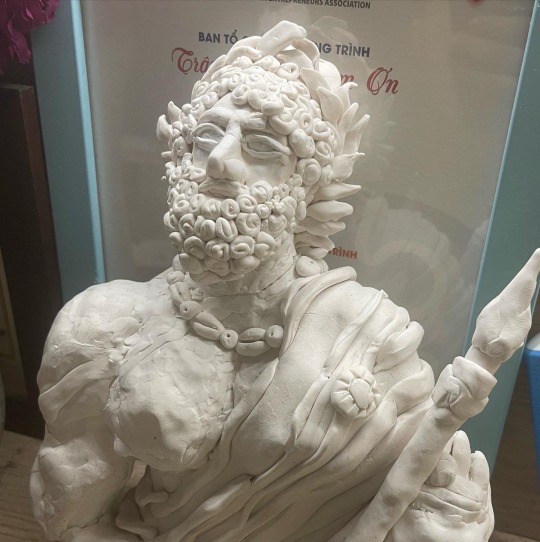
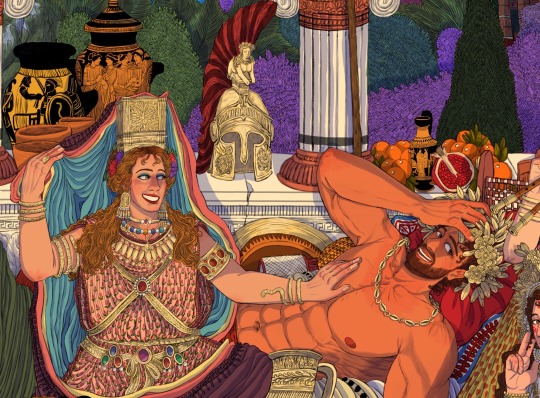
Finally finished sculpting little busts of Aphrodite and Ares, after more than a year of not touching polymer clay that I once used for uni🏛🏺
The stylized depiction of the war god Ares (especially the beard curls) were inspired from the limestone Archaic Greek votive statues of Cypriot bearded priests/ wealthy dignitaries that were found in the temple of Resheph-Apollo in Idalion (modern day Dali district in Nicosia, Cyprus); while Aphrodite herself were inspired from the limestone bas-reliefs of Inanna/Ishtar in Palmyra, Syria, and the famous funerary reliefs of the city’s affluent wealthy citizens over there, too. The exchanging of ideas, beliefs and cultures of the East and West that we can see through various ancient cities in the Levantine region like Palmyra, and Ancient Phoenician/ Greek little jewelry trinkets/ objects always have a soft spot on my heart. ❤️❤️❤️
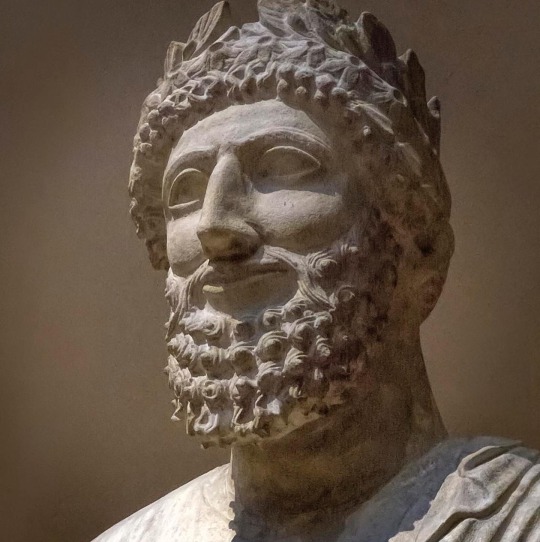

#ancient greek#ancient near east#aphrodite#ares#my art#art history#mars#venus#polymer clay#polymer sculpture#ares and aphrodite
26 notes
·
View notes
Text

So, this is official Ea-Naṣir merch. And it is wrong. This sentence would have been written differently. What you can read here is
ri-ib-am KÙ.BABBAR-i e-a-na-ṣi-ir
But the Babylonians would have written
ri-ba-am KÙ.BABBAR-i d^é-a-na-ṣi-ir
The "Ea" in Ea-naṣir is actually a deity and is always and consistently written with the sign "é" and not with the sign "e". Since it is a divine name, the little d stands in front of the name to show ancient cuneiform readers that the following word is a divine name.
And don't get me started on the "stylized English" version. This is not how any of this works! Why didn't they ask a real assyriologist or expert in cuneiform/Babylonian philology...?
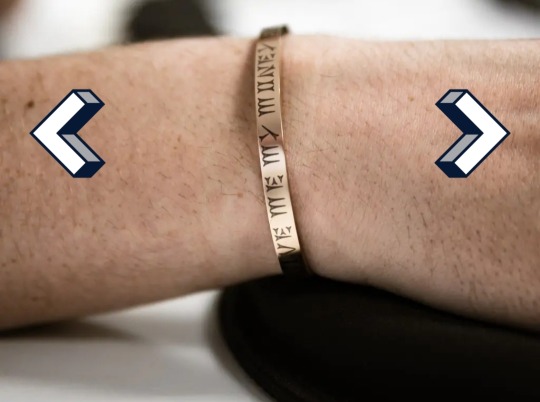
10 notes
·
View notes
Text
Deity Dagan
Originally a god of West Semitic speakers from the Levant, but worshipped widely throughout the Near East, including Mesopotamia.
Deity of grain, as well as its cultivation and storage. Indeed, the common word for "grain" in Ugaritic and Hebrew is dagan. According to one Sumerian tradition and to the much later Philo of Byblos, Dagan invented the plow. In the north, he was sometimes identified with Adad. Thus, he may have had some of the characteristics of a storm god. In one tradition his wife was Ishara, in another Salas, usually wife of Adad. Salas was originally a goddess of the Hurrians. Dagan also had netherworld connections. According to an Assyrian composition, he was a judge of the dead in the lower world, serving with Nergal and Misa-ru(m), the god of justice. A tradition going back at least to the fourth century BCE identified Dagan as a fish god, but it is almost certainly incorrect, presumably having been based upon a false etymology that interpreted the element "Dag" in Dagan as deriving from the Hebrew word dag "fish."
The earliest mentions of him come from texts that indicate that, in Early Dynastic times, Dagan was worshipped at Ebla. Dagan was taken into the Sumerian pantheon quite early as a minor god in the circle of Enlil at Nip-pur. Kings of the Old Akkadian peri-od, including Sargon and Narām-Sin, credited much of their success as conquerors to Dagan. Sargon recorded that he "prostrated (himself in prayer before Dagan in Tutul [sic]" (Oppen-heim, ANET: 268). At the same time, he gave to the god a large area of the country he had just conquered, including Mari, Ebla, and larmuti in western Syria. A number of letters from the Mari archives, dated mainly to the reign of Zimri-Lim, record that Dagãn was a source of divine revela-tion. The letters reported prophetic dreams, a number of which came from Dagan, conveyed by his prophets and ecstatics. In his law code, Hammu-rapi credits Dagan with helping him subdue settlements along the Euphrates.
The Assyrian king Samsi-Adad I commissioned a temple for him at Terqa, upstream from Mari, where funeral rites for the Mari Dynasty took place.
In the Old Babylonian period, kings of the Amorites erected temples for Dagan at Isin and Ur. In the Anzû(m) myth, Dagan was favorably coupled with Anu(m). At Ugarit Dagan was closely associated with, if not equated to, the supreme god El/I(u). Although he is mentioned in the mythic compositions of Ugarit as the father of the storm god Ba'lu/ Had(d)ad, Dagan plays only a very minor role. His popularity is indicated by his importance in offering and god lists, one of which places him third, after the two chief gods and before the active and powerful god Ba'lu/ Had(d)ad. Dagan is attested in Ugaritic theophoric names. In Ugaritic texts the god is often referred to as "Dagan of Tuttul." It might also be the case that one of the two major temples of the city of Ugarit was dedicated to him, and he might there have been identified with the chief god I(u) / El.
Festivals for Dagãn took place at Ter-ga and Tuttul, both of which were cult centers of the god. He was certainly worshipped at Ebla and also at Mari.
At Mari, in Old Babylonian times, he appears as fourth deity on a god list; that is, he was very important. He was venerated also at Emar. There a "Sacred Marriage" ritual between Dagan and the goddess Nin-kur was celebrated.
At the same city, a festival was held in honor of "Dagan-Lord-of-the-Cattle," at which the herds of cattle and prob. ably sheep were blessed.
According to the Hebrew Bible, Dagan was the national god of the Philistines. I Samuel:5-6 tells of the capture of the Ark of the Covenant by the Philistines. It was customary in the Ancient Near East for the conquerors to carry off the deity statues of the conquered to mark the surrender not only of the people, but also of their deities.
So the Philistines took the Ark, the symbol of the god of the Israelites, into the temple of Dagan at Ashdod. Since the Israelites had no statues of their deity, the much revered Ark was an obvious substitute. In this way, the Philistines marked the submission of the Israelite god to Dagan. However, on the next day, the people of Ashdod found the statue of Dagan lying face down in front of the Ark. The following day the same thing happened except that the head and hands of Dagan's statue lay broken on the temple threshold. This biblical account seems to be an etiology for a practice of the priests of the temple of Dagan at Ashdod, for it states that for this reason it is the custom of the priests of Dagan not to tread on the threshold as they enter the temple of Dagan. The best-known of the biblical stories that mention Dagan is in Judges 16, the tale of Samson and Delilah. After Delilah arranged for the Philistines of Gaza to capture Samson, they blinded him, shackled him, and made him a slave at a mill. During a festival to Dagan, the Philistines took Samson to be exhibited in Dagan's temple, where thou sands of Philistines had gathered for the celebrations. After praying to the Israelite god, the now long haired Samson got back his old strength. By pushing against two central pillars, he brought the temple crashing down on himself and on more Philistines than he had killed in his whole lifetime of killing Philistines.
— From a Handbook to Ancient Near Eastern Gods & Goddesses by Frayne & Stuckey page 67-69
#pagan#polytheism#levpag#philistines#israelites#canaanites#assyrians#1 samuel#tanakh#mesopotamians#dagan#dagan deity#deity#god#quote#sumerian polytheism#levant#ancient near east#landof2rivers#quote pile#put this in text for someone so thought id post it#eblaite#ebla
8 notes
·
View notes